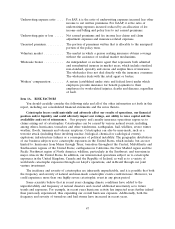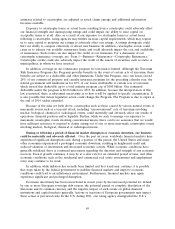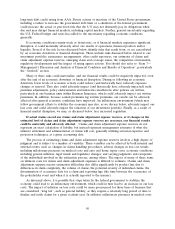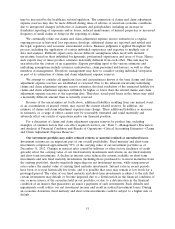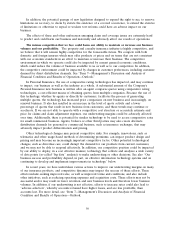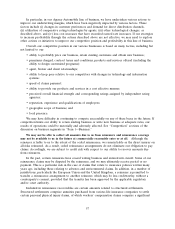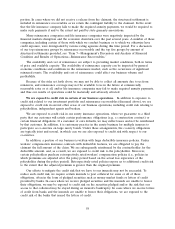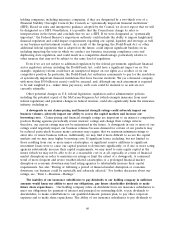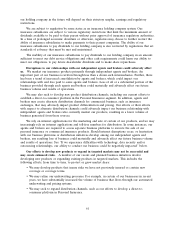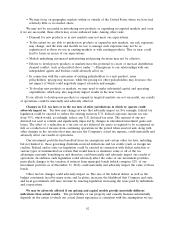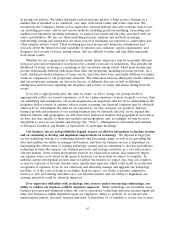Travelers 2012 Annual Report Download - page 68
Download and view the complete annual report
Please find page 68 of the 2012 Travelers annual report below. You can navigate through the pages in the report by either clicking on the pages listed below, or by using the keyword search tool below to find specific information within the annual report.In addition, the potential passage of new legislation designed to expand the right to sue, to remove
limitations on recovery, to deem by statute the existence of a covered occurrence, to extend the statutes
of limitations or otherwise to repeal or weaken tort reforms could have an adverse impact on our
business.
The effects of these and other unforeseen emerging claim and coverage issues are extremely hard
to predict and could harm our business and materially and adversely affect our results of operations.
The intense competition that we face could harm our ability to maintain or increase our business
volumes and our profitability. The property and casualty insurance industry is highly competitive, and
we believe that it will remain highly competitive for the foreseeable future. We compete with both
domestic and foreign insurers which may offer products at prices and on terms that are not consistent
with our economic standards in an effort to maintain or increase their business. The competitive
environment in which we operate could also be impacted by current general economic conditions,
which could reduce the volume of business available to us as well as to our competitors. In addition,
the competitive environment could be impacted by changes in customer preferences, including customer
demand for direct distribution channels. See ‘‘Item 7—Management’s Discussion and Analysis of
Financial Condition and Results of Operation—Outlook.’’
In Personal Insurance, the use of comparative rating technologies has impacted, and may continue
to impact, our business as well as the industry as a whole. A substantial amount of the Company’s
Personal Insurance new business is written after an agent compares quotes using comparative rating
technologies, a cost-efficient means of obtaining quotes from multiple companies. Because the use of
this technology, whether by agents or directly by customers, facilitates the process of generating
multiple quotes, the technology has increased price comparison on new business and, increasingly, on
renewal business. It also has resulted in an increase in the level of quote activity and a lower
percentage of quotes that result in new business from customers, and these trends may continue or
accelerate. If we are not able to operate with a competitive cost structure or accurately estimate and
price for claims and claim adjustment expenses, our underwriting margins could be adversely affected
over time. Additionally, there is potential for similar technology to be used to access comparative rates
for small commercial business. Agents, brokers or other third parties may also create alternate
distribution channels for personal or commercial business, such as insurance exchanges, that may
adversely impact product differentiation and pricing.
Other technological changes may present competitive risks. For example, innovations, such as
telematics and other usage-based methods of determining premiums, can impact product design and
pricing and may become an increasingly important competitive factor. Other potential technological
changes, such as driverless cars, could disrupt the demand for our products from current customers,
and we may not be able to respond effectively. In addition, our competitive position could be impacted
by our ability to deploy, in a cost effective manner, technology that collects and analyzes a wide variety
of data points (so-called ‘‘big data’’ analysis) to make underwriting or other decisions. See also ‘‘Our
business success and profitability depend, in part, on effective information technology systems and on
continuing to develop and implement improvements in technology’’ below.
In recent years, we have undertaken various actions to improve our underwriting margins on many
of our insurance products, and competitive dynamics may impact the success of these efforts. These
efforts include seeking improved rates, as well as improved terms and conditions, and also include
other initiatives, such as reducing operating expenses and acquisition costs. These efforts may not be
successful and/or may result in lower retention and new business levels and therefore lower business
volumes. In addition, if our underwriting is not effective, efforts to increase rates could also lead to
‘‘adverse selection’’, whereby accounts retained have higher losses, and are less profitable, than
accounts lost. For more detail, see ‘‘Item 7—Management’s Discussion and Analysis of Financial
Condition and Results of Operation—Outlook.
56



